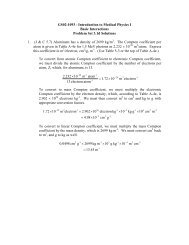link to lecture transcript - UT-H GSBS Medical Physics Class Site
link to lecture transcript - UT-H GSBS Medical Physics Class Site
link to lecture transcript - UT-H GSBS Medical Physics Class Site
Create successful ePaper yourself
Turn your PDF publications into a flip-book with our unique Google optimized e-Paper software.
Let us first review what we’ve covered so far about Comp<strong>to</strong>n scatter cross sections.<br />
We’ve said that the Comp<strong>to</strong>n scatter cross section is equal <strong>to</strong> the classical scatter<br />
cross section in the limit of zero energy. It’s also equal <strong>to</strong> the classical scatter cross<br />
section for forward scatter, that is, θ = 0. The Comp<strong>to</strong>n scatter cross section<br />
becomes more peaked in the forward direction as the pho<strong>to</strong>n energy increases. The<br />
Comp<strong>to</strong>n scatter cross section for backscattered pho<strong>to</strong>ns, that is, θ = π, is lower than<br />
that for θ = 0 by about one order of magnitude for pho<strong>to</strong>ns of energy 1 MeV, and<br />
about two orders of magnitude for pho<strong>to</strong>ns of energy 10 MeV. This is what we<br />
know so far about Comp<strong>to</strong>n scatter.<br />
What we are going <strong>to</strong> do now is try <strong>to</strong> get an equation, first of all for the <strong>to</strong>tal scatter<br />
cross section, and then we will look at the energy gy dependence p of the cross section.<br />
The <strong>to</strong>tal scatter cross section is the attenuation coefficient per unit incident pho<strong>to</strong>n<br />
fluence. Thus, from the scatter cross section we will be able <strong>to</strong> obtain the<br />
attenuation coefficient.<br />
2





